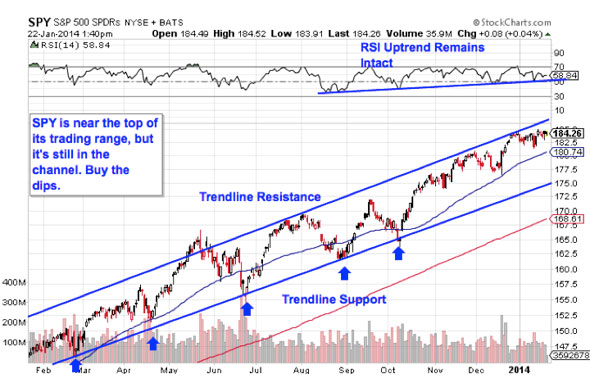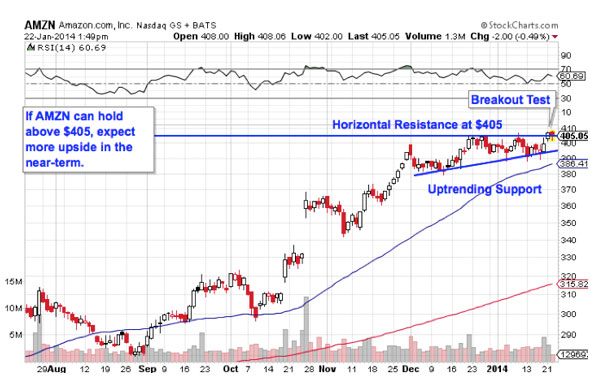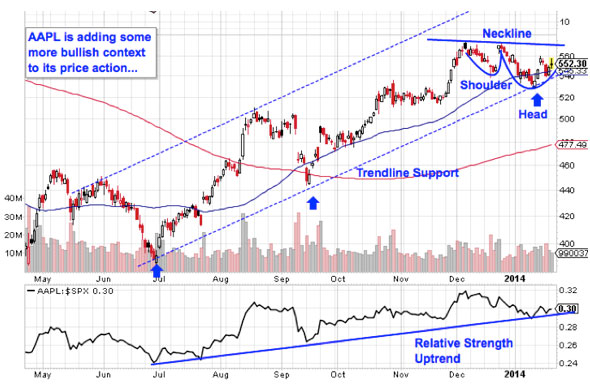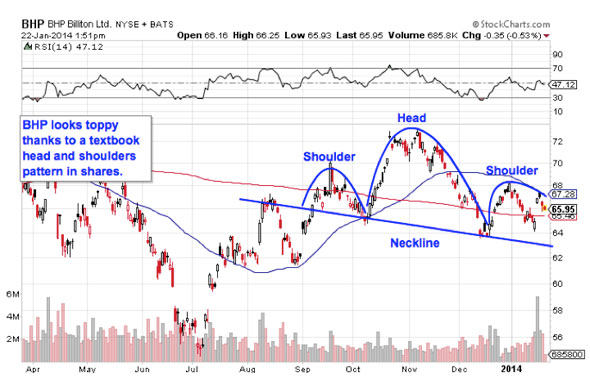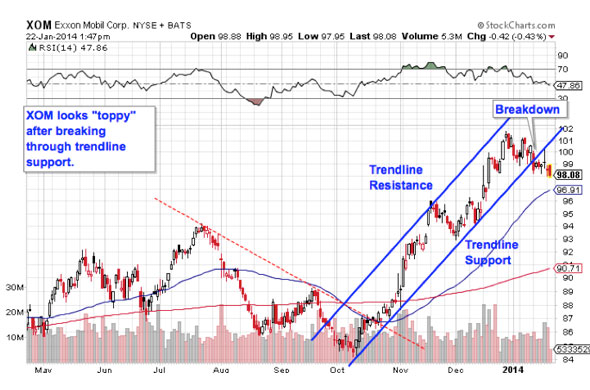Whole Foods Market Inc. (WFM) began its operations in 1980 and has since grown to become the world's leading retailer of natural and organic foods. It is also the first Certified Organic Grocer in the U.S. The company has a strong brand image and its banner is a synonym of quality and health. The firm offers a wide range of organic products, including those of its private labels, through a network of 373 stores mostly located in the U.S., but also in Canada and the UK. Moreover, the company owns and operates 10 regional distribution centers and four seafood processing and distribution facilities.
An Intangible Asset
Whole Foods's leading position in the $80 billion domestic market is the result of a strong brand image that has earned the firm a narrow economic moat. This intangible asset has enabled the company to sell its products at premium price points and also to attain above-average sales per square foot, thus achieving excess returns on invested capital. Furthermore, it favors a higher private-label penetration, thereby strengthening customers' loyalty while boosting margins.
Rivalry
Although switching costs are almost nonexistent in the grocery industry, Whole Foods has developed a solid competitive position through a differentiated value proposition that comprises a vast array of products offering and distinct customer service. These traits and its large network of stores have kept the firm ahead of notable competitors like The Fresh Market Inc. (TFM) and Sprouts Farmers Market Inc. (SFM). These rivals operate roughly 150 stores each and handle an average of 10,000 stock- keeping units against 20,000 at Whole Foods.
Sourcing
In order to maximize volume discount, Whole Foods purchases at regional or national scales. While many of its perishable products are obtained from local producers, almost a third of the company's purchases are sourced from United Natural Foods Inc. (UNFI). Their distribution agreement, valid through 2020, stipulates that UNFI will be the company's main provider of frozen foods and groceries. However, the company seeks to diversify its supplier base by sourcing form local farmers who are eager to suit its high-quality food production standards.
Growth Drivers
The company's successful mix of effective inventory management and strict cost-control measures adds to a revamp of its pricing strategy and a greater focus on value offerings. Hence, Whole Foods has delivered healthy gross margins in the range of 34.8% to 35.5% over the last three years.
Furthermore, the company continues to open new stores and to integrate regional acquisitions. It opened 32 new locations in 2013 and expects to reach the count of 500 by 2017. As store volume augments, the firm benefits from both lower per unit costs and sales increases. Its comps, in turn, also help bolster margins, since they continue to follow an upward trend. Moving forward, Whole Foods expects an escalation of 11% to 12% in total sales for 2014.
Sturdy Growth Profile
Whole Foods' strong brand image, high-quality products and marketing expertise have earned the firm one of the strongest growth profiles in the industry. Its stock trades at 35.80 its trailing earnings, a premium compared to its peers' average of 19.10. Its earnings per share growth, however, showcases an impressive 27.20% against the industry median of 5.10%, which will lead to more attractive multiples. Further, the stock delivered a healthy return on equity of 14.20% compared to its rivals' 9.80% average and its return on capital an outstanding 36.40% against its peers' average of 19.70%. Investment guru Ray Dalio (Trades, Portfolio) recently incorporated Whole Foods to its portfolio, backing my bullish feeling about the firm's exceptional growth potential.
Disclosure: Patricio Kehoe holds no position in any stocks mentioned.
About the author:Patricio KehoeA fundamental analyst at Lone Tree Analytics
| Currently 5.00/512345 Rating: 5.0/5 (1 vote) | Voters: |

Subscribe via Email

Subscribe RSS Comments Please leave your comment:
More GuruFocus Links
| Latest Guru Picks | Value Strategies |
| Warren Buffett Portfolio | Ben Graham Net-Net |
| Real Time Picks | Buffett-Munger Screener |
| Aggregated Portfolio | Undervalued Predictable |
| ETFs, Options | Low P/S Companies |
| Insider Trends | 10-Year Financials |
| 52-Week Lows | Interactive Charts |
| Model Portfolios | DCF Calculator |
RSS Feed  | Monthly Newsletters |
| The All-In-One Screener | Portfolio Tracking Tool |
MORE GURUFOCUS LINKS
| Latest Guru Picks | Value Strategies |
| Warren Buffett Portfolio | Ben Graham Net-Net |
| Real Time Picks | Buffett-Munger Screener |
| Aggregated Portfolio | Undervalued Predictable |
| ETFs, Options | Low P/S Companies |
| Insider Trends | 10-Year Financials |
| 52-Week Lows | Interactive Charts |
| Model Portfolios | DCF Calculator |
RSS Feed  | Monthly Newsletters |
| The All-In-One Screener | Portfolio Tracking Tool |
WFM STOCK PRICE CHART

55.48 (1y: +25%) $(function(){var seriesOptions=[],yAxisOptions=[],name='WFM',display='';Highcharts.setOptions({global:{useUTC:true}});var d=new Date();$current_day=d.getDay();if($current_day==5||$current_day==0||$current_day==6){day=4;}else{day=7;} seriesOptions[0]={id:name,animation:false,color:'#4572A7',lineWidth:1,name:name.toUpperCase()+' stock price',threshold:null,data:[[1363237200000,44.29],[1363323600000,43.53],[1363582800000,43.215],[1363669200000,42.78],[1363755600000,43.145],[1363842000000,43.13],[1363928400000,43.89],[1364187600000,43.175],[1364274000000,43.435],[1364360400000,43.63],[1364446800000,43.375],[1364792400000,42.67],[1364878800000,42.258],[1364965200000,41.615],[1365051600000,41.555],[1365138000000,41.51],[1365397200000,41.87],[1365483600000,41.84],[1365570000000,43.185],[1365656400000,43.71],[1365742800000,44.005],[1366002000000,43.285],[1366088400000,43.51],[1366174800000,42.92],[1366261200000,42.505],[1366347600000,43.035],[1366606800000,43.55],[1366693200000,44.39],[1366779600000,44.595],[1366866000000,44.125],[1366952400000,44.305],[1367211600000,44.065],[1367298000000,44.16],[1367384400000,44.51],[1367470800000,45.135],[1367557200000,45.73],[1367816400000,45.9],[1367902800000,46.4],[1367989200000,51.095],[1368075600000,50.435],[1368162000000,50.445],[1368421200000,50.68],[1368507600000,51.325],[1368594000000,51.665],[1368680400000,51.02],[1368766800000,51.885],[1369026000000,51.87],[1369112400000,52.535],[1369198800000,51.775],[1369285200000,52.29],[1369371600000,52.4],[1369717200000,52.855],[1369803600000,52.705],[1369890000000,53.17],[1369976400000,51.86],[1370235600000,52.38],[1370322000000,51.24],[1370408400000,50.42],[1370494800000,50.88],[1370581200000,51.51],[1370840400000,52.05],[1370926800000,51.25],[1371013200000,50.72],[1371099600000,51.35],[1371186000000,51.38],[1371445200000,52.31],[1371531600000,52.73],[1371618000000,51.93],[1371704400000,50.71],[1371790800000,51.14],[1372050000000,50.83],[1372136400000,51.92],[1372222800000,52.86],[1372309200000,52.37],[1372395600000,51.48],[1372654800000,52.06],[1372741200000,52.68],[1372827600000,53.03],[1373000400000,53.23],[1373259600000,53.85],[1373346000000,54.71],[1373432400000,54.66],[1373518800000,55.77],[1373605200000,56.23],[1373864400000,56.67],[1373950800000! ,56.38],[1374037200000,56.235],[1374123600000,56.22],[1374210000000,55.93],[1374469200000,55.97],[1374555600000,55.07],[1374642000000,54.49],[1374728400000,55.12],[1374814800000,55.97],[1375074000000,55.51],[1375160400000,55.62],[1375246800000,55.58],[1375333200000,55.14],[1375419600000,54.85],[1375678800000,55.73],[1375765200000,56.07],[1375851600000,55.4],[1375938000000,55.9],[1376024400000,55.42],[1376283600000,55.4],[1376370000000,55.53],[1376456400000,54.61],[1376542800000,53.82],[1376629200000,52.96],[1376888400000,52.55],[1376974800000,52.44],[1377061200000,52.2],[1377147600000,52.86],[1377234000000,52.88],[1377493200000,52.39],[1377579600000,51.86],[1377666000000,51.48],[1377752400000,52.47],[1377838800000,52.75],[1378184400000,53.31],[1378270800000,53.81],[1378357200000,54.19],[1378443600000,54.52],[1378702800000,54.91],[1378789200000,55.48],[1378875600000,56.09],[1378962000000,56.36],[1379048400000,57.11],[1379307600000,57.71],[1379394000000,58.14],[1379480400000,59.32],[1379566800000,58.54],[1379653200000,57.85],[1379912400000,58.24],[1379998800000,58.55],[1380085200000,58.33],[1380171600000,58.51],[1380258000000,58.33],[1380517200000,58.5],[1380603600000,59.12],[1380690000000,59.59],[1380776400000,58.89],[1380862800000,59.55],[1381122000000,59.15],[1381208400000,59.09],[1381294800000,58.42],[1381381200000,59.81],[1381467600000,61.18],[1381726800000,61.89],[1381813200000,61.51],[1381899600000,62.658],[1381986000000,63.4],[1382072400000,63.85],[1382331600000,63.86],[1382418000000,64.03],[1382504400000,64.14],[1382590800000,64.59],[1382677200000,65.24],[1382936400000,64.83],[1383022800000,64.85],[1383109200000,63.96],[1383195600000,63.13],[1383282000000,63.3],[1383544800000,63.48],[1383631200000,63.69],[1383717600000,64.47],[1383804000000,57.26],[1383890400000,58.55],[1384149600000,57.8],[1384236000000,59],[1384322400000,59.05],[1384408800000,59.27],[1384495200000,58.84],[1384754400000,56.99],[1384840800000,55.72],[1384927200000,55.84],[1385013600000,56.48


 Popular Posts: 10 Oil and Gas Stocks to Buy Now15 Oil and Gas Stocks to Sell NowBiggest Movers in Energy Stocks Now – NGLS EXXI WTI TPLM Recent Posts: Biggest Movers in Capital Goods Stocks Now – ATRO APOG AIR TEX Hottest Healthcare Stocks Now – PCRX ISRG SHPG BIIB Hottest Financial Stocks Now – AB NBG BX BOKF View All Posts 4 Energy Services Stocks to Sell Now
Popular Posts: 10 Oil and Gas Stocks to Buy Now15 Oil and Gas Stocks to Sell NowBiggest Movers in Energy Stocks Now – NGLS EXXI WTI TPLM Recent Posts: Biggest Movers in Capital Goods Stocks Now – ATRO APOG AIR TEX Hottest Healthcare Stocks Now – PCRX ISRG SHPG BIIB Hottest Financial Stocks Now – AB NBG BX BOKF View All Posts 4 Energy Services Stocks to Sell Now  Related EDN Utility Sector Rises; Elizabeth Arden Shares Slide Over 3.6% Mid-Morning Market Update: Markets Mostly Higher; Walgreen Profit Misses Estimates
Related EDN Utility Sector Rises; Elizabeth Arden Shares Slide Over 3.6% Mid-Morning Market Update: Markets Mostly Higher; Walgreen Profit Misses Estimates  NEW YORK (CNNMoney) Home prices jumped nearly 11% in April , and are now up more than 22% from the bottom three years ago.
NEW YORK (CNNMoney) Home prices jumped nearly 11% in April , and are now up more than 22% from the bottom three years ago. 
 55.48 (1y: +25%) $(function(){var seriesOptions=[],yAxisOptions=[],name='WFM',display='';Highcharts.setOptions({global:{useUTC:true}});var d=new Date();$current_day=d.getDay();if($current_day==5||$current_day==0||$current_day==6){day=4;}else{day=7;} seriesOptions[0]={id:name,animation:false,color:'#4572A7',lineWidth:1,name:name.toUpperCase()+' stock price',threshold:null,data:[[1363237200000,44.29],[1363323600000,43.53],[1363582800000,43.215],[1363669200000,42.78],[1363755600000,43.145],[1363842000000,43.13],[1363928400000,43.89],[1364187600000,43.175],[1364274000000,43.435],[1364360400000,43.63],[1364446800000,43.375],[1364792400000,42.67],[1364878800000,42.258],[1364965200000,41.615],[1365051600000,41.555],[1365138000000,41.51],[1365397200000,41.87],[1365483600000,41.84],[1365570000000,43.185],[1365656400000,43.71],[1365742800000,44.005],[1366002000000,43.285],[1366088400000,43.51],[1366174800000,42.92],[1366261200000,42.505],[1366347600000,43.035],[1366606800000,43.55],[1366693200000,44.39],[1366779600000,44.595],[1366866000000,44.125],[1366952400000,44.305],[1367211600000,44.065],[1367298000000,44.16],[1367384400000,44.51],[1367470800000,45.135],[1367557200000,45.73],[1367816400000,45.9],[1367902800000,46.4],[1367989200000,51.095],[1368075600000,50.435],[1368162000000,50.445],[1368421200000,50.68],[1368507600000,51.325],[1368594000000,51.665],[1368680400000,51.02],[1368766800000,51.885],[1369026000000,51.87],[1369112400000,52.535],[1369198800000,51.775],[1369285200000,52.29],[1369371600000,52.4],[1369717200000,52.855],[1369803600000,52.705],[1369890000000,53.17],[1369976400000,51.86],[1370235600000,52.38],[1370322000000,51.24],[1370408400000,50.42],[1370494800000,50.88],[1370581200000,51.51],[1370840400000,52.05],[1370926800000,51.25],[1371013200000,50.72],[1371099600000,51.35],[1371186000000,51.38],[1371445200000,52.31],[1371531600000,52.73],[1371618000000,51.93],[1371704400000,50.71],[1371790800000,51.14],[1372050000000,50.83],[1372136400000,51.92],[1372222800000,52.86],[1372309200000,52.37],[1372395600000,51.48],[1372654800000,52.06],[1372741200000,52.68],[1372827600000,53.03],[1373000400000,53.23],[1373259600000,53.85],[1373346000000,54.71],[1373432400000,54.66],[1373518800000,55.77],[1373605200000,56.23],[1373864400000,56.67],[1373950800000! ,56.38],[1374037200000,56.235],[1374123600000,56.22],[1374210000000,55.93],[1374469200000,55.97],[1374555600000,55.07],[1374642000000,54.49],[1374728400000,55.12],[1374814800000,55.97],[1375074000000,55.51],[1375160400000,55.62],[1375246800000,55.58],[1375333200000,55.14],[1375419600000,54.85],[1375678800000,55.73],[1375765200000,56.07],[1375851600000,55.4],[1375938000000,55.9],[1376024400000,55.42],[1376283600000,55.4],[1376370000000,55.53],[1376456400000,54.61],[1376542800000,53.82],[1376629200000,52.96],[1376888400000,52.55],[1376974800000,52.44],[1377061200000,52.2],[1377147600000,52.86],[1377234000000,52.88],[1377493200000,52.39],[1377579600000,51.86],[1377666000000,51.48],[1377752400000,52.47],[1377838800000,52.75],[1378184400000,53.31],[1378270800000,53.81],[1378357200000,54.19],[1378443600000,54.52],[1378702800000,54.91],[1378789200000,55.48],[1378875600000,56.09],[1378962000000,56.36],[1379048400000,57.11],[1379307600000,57.71],[1379394000000,58.14],[1379480400000,59.32],[1379566800000,58.54],[1379653200000,57.85],[1379912400000,58.24],[1379998800000,58.55],[1380085200000,58.33],[1380171600000,58.51],[1380258000000,58.33],[1380517200000,58.5],[1380603600000,59.12],[1380690000000,59.59],[1380776400000,58.89],[1380862800000,59.55],[1381122000000,59.15],[1381208400000,59.09],[1381294800000,58.42],[1381381200000,59.81],[1381467600000,61.18],[1381726800000,61.89],[1381813200000,61.51],[1381899600000,62.658],[1381986000000,63.4],[1382072400000,63.85],[1382331600000,63.86],[1382418000000,64.03],[1382504400000,64.14],[1382590800000,64.59],[1382677200000,65.24],[1382936400000,64.83],[1383022800000,64.85],[1383109200000,63.96],[1383195600000,63.13],[1383282000000,63.3],[1383544800000,63.48],[1383631200000,63.69],[1383717600000,64.47],[1383804000000,57.26],[1383890400000,58.55],[1384149600000,57.8],[1384236000000,59],[1384322400000,59.05],[1384408800000,59.27],[1384495200000,58.84],[1384754400000,56.99],[1384840800000,55.72],[1384927200000,55.84],[1385013600000,56.48
55.48 (1y: +25%) $(function(){var seriesOptions=[],yAxisOptions=[],name='WFM',display='';Highcharts.setOptions({global:{useUTC:true}});var d=new Date();$current_day=d.getDay();if($current_day==5||$current_day==0||$current_day==6){day=4;}else{day=7;} seriesOptions[0]={id:name,animation:false,color:'#4572A7',lineWidth:1,name:name.toUpperCase()+' stock price',threshold:null,data:[[1363237200000,44.29],[1363323600000,43.53],[1363582800000,43.215],[1363669200000,42.78],[1363755600000,43.145],[1363842000000,43.13],[1363928400000,43.89],[1364187600000,43.175],[1364274000000,43.435],[1364360400000,43.63],[1364446800000,43.375],[1364792400000,42.67],[1364878800000,42.258],[1364965200000,41.615],[1365051600000,41.555],[1365138000000,41.51],[1365397200000,41.87],[1365483600000,41.84],[1365570000000,43.185],[1365656400000,43.71],[1365742800000,44.005],[1366002000000,43.285],[1366088400000,43.51],[1366174800000,42.92],[1366261200000,42.505],[1366347600000,43.035],[1366606800000,43.55],[1366693200000,44.39],[1366779600000,44.595],[1366866000000,44.125],[1366952400000,44.305],[1367211600000,44.065],[1367298000000,44.16],[1367384400000,44.51],[1367470800000,45.135],[1367557200000,45.73],[1367816400000,45.9],[1367902800000,46.4],[1367989200000,51.095],[1368075600000,50.435],[1368162000000,50.445],[1368421200000,50.68],[1368507600000,51.325],[1368594000000,51.665],[1368680400000,51.02],[1368766800000,51.885],[1369026000000,51.87],[1369112400000,52.535],[1369198800000,51.775],[1369285200000,52.29],[1369371600000,52.4],[1369717200000,52.855],[1369803600000,52.705],[1369890000000,53.17],[1369976400000,51.86],[1370235600000,52.38],[1370322000000,51.24],[1370408400000,50.42],[1370494800000,50.88],[1370581200000,51.51],[1370840400000,52.05],[1370926800000,51.25],[1371013200000,50.72],[1371099600000,51.35],[1371186000000,51.38],[1371445200000,52.31],[1371531600000,52.73],[1371618000000,51.93],[1371704400000,50.71],[1371790800000,51.14],[1372050000000,50.83],[1372136400000,51.92],[1372222800000,52.86],[1372309200000,52.37],[1372395600000,51.48],[1372654800000,52.06],[1372741200000,52.68],[1372827600000,53.03],[1373000400000,53.23],[1373259600000,53.85],[1373346000000,54.71],[1373432400000,54.66],[1373518800000,55.77],[1373605200000,56.23],[1373864400000,56.67],[1373950800000! ,56.38],[1374037200000,56.235],[1374123600000,56.22],[1374210000000,55.93],[1374469200000,55.97],[1374555600000,55.07],[1374642000000,54.49],[1374728400000,55.12],[1374814800000,55.97],[1375074000000,55.51],[1375160400000,55.62],[1375246800000,55.58],[1375333200000,55.14],[1375419600000,54.85],[1375678800000,55.73],[1375765200000,56.07],[1375851600000,55.4],[1375938000000,55.9],[1376024400000,55.42],[1376283600000,55.4],[1376370000000,55.53],[1376456400000,54.61],[1376542800000,53.82],[1376629200000,52.96],[1376888400000,52.55],[1376974800000,52.44],[1377061200000,52.2],[1377147600000,52.86],[1377234000000,52.88],[1377493200000,52.39],[1377579600000,51.86],[1377666000000,51.48],[1377752400000,52.47],[1377838800000,52.75],[1378184400000,53.31],[1378270800000,53.81],[1378357200000,54.19],[1378443600000,54.52],[1378702800000,54.91],[1378789200000,55.48],[1378875600000,56.09],[1378962000000,56.36],[1379048400000,57.11],[1379307600000,57.71],[1379394000000,58.14],[1379480400000,59.32],[1379566800000,58.54],[1379653200000,57.85],[1379912400000,58.24],[1379998800000,58.55],[1380085200000,58.33],[1380171600000,58.51],[1380258000000,58.33],[1380517200000,58.5],[1380603600000,59.12],[1380690000000,59.59],[1380776400000,58.89],[1380862800000,59.55],[1381122000000,59.15],[1381208400000,59.09],[1381294800000,58.42],[1381381200000,59.81],[1381467600000,61.18],[1381726800000,61.89],[1381813200000,61.51],[1381899600000,62.658],[1381986000000,63.4],[1382072400000,63.85],[1382331600000,63.86],[1382418000000,64.03],[1382504400000,64.14],[1382590800000,64.59],[1382677200000,65.24],[1382936400000,64.83],[1383022800000,64.85],[1383109200000,63.96],[1383195600000,63.13],[1383282000000,63.3],[1383544800000,63.48],[1383631200000,63.69],[1383717600000,64.47],[1383804000000,57.26],[1383890400000,58.55],[1384149600000,57.8],[1384236000000,59],[1384322400000,59.05],[1384408800000,59.27],[1384495200000,58.84],[1384754400000,56.99],[1384840800000,55.72],[1384927200000,55.84],[1385013600000,56.48


 ) were up on Friday morning following reports that Ireland-based Shire Plc. has rejected its takeover offer.
) were up on Friday morning following reports that Ireland-based Shire Plc. has rejected its takeover offer.
 Daniel Acker/Bloomberg via Getty Images A combination of higher prices for new cars and relatively low rates for auto loans means Americans are borrowing a record amount to pay for their new rides. According to Experian Automotive, which tracks millions of auto loans written each quarter, the average amount borrowed by car buyers last quarter climbed above $27,000 for the first time ever. "It's not surprising buyers are borrowing more," said Melinda Zabritski, Experian's senior director of automotive credit. "If you look at the most popular segments, they are full-size pickups and SUVs. It's hard to find one of those models new and fully loaded for under $30,000." According to Experian, the average auto loan in fourth quarter 2013 was $27,430 -- an increase of $739 compared with the same period of 2012. The average used car loan was $345 higher, coming in at $17,974. Those with non-prime credit ratings -- or credit scores between 620 and 679 -- had the highest average auto loan. For these borrowers, the average new car loan rose more than $1,500, to a new high of $29,385. And as their loans rise, keeping the monthly payment as low as possible has become more of a challenge -- even as car buyers stretch their loans over longer periods of time. According to Experian, the average monthly payment for a new car auto loan rose $11 to $471 in the fourth quarter; the average monthly payment for a used car loan edged $4 higher, to $352. Not surprisingly, those with subprime credit ratings -- credit scores between 550 and 619 -- had the highest average monthly payment, of $499. "I expect that monthly payment to continue rising and go above $500," Zabritski said. "There's always a tipping point where buyers say, 'I can't pay that much every month.' So far, we haven't seen the flashing lights go off indicating buyers are at a tipping point." The payments are rising despite an increasing number of car buyers opting to stretch their loans over six or seven years. According to Experian, a record 20 percent of all new car auto loans in the fourth quarter were more than six years in length. Overall, the average auto loan is scheduled to last 5 years and 3 months -- but that could be rising. J.D. Power said last week that February was on track to have one-third of new car auto loans last at least six years. Bigger auto loans shouldn't come as a surprise, given the average transaction price -- or the amount buyers are paying at dealerships -- climbed 1.9 percent to $32,160 in February, according to Kelley Blue Book. It's the second straight month transaction prices came in above $32,000, as car buyers are adding navigation systems, in-car connectivity and infotainment systems to their vehicles.
Daniel Acker/Bloomberg via Getty Images A combination of higher prices for new cars and relatively low rates for auto loans means Americans are borrowing a record amount to pay for their new rides. According to Experian Automotive, which tracks millions of auto loans written each quarter, the average amount borrowed by car buyers last quarter climbed above $27,000 for the first time ever. "It's not surprising buyers are borrowing more," said Melinda Zabritski, Experian's senior director of automotive credit. "If you look at the most popular segments, they are full-size pickups and SUVs. It's hard to find one of those models new and fully loaded for under $30,000." According to Experian, the average auto loan in fourth quarter 2013 was $27,430 -- an increase of $739 compared with the same period of 2012. The average used car loan was $345 higher, coming in at $17,974. Those with non-prime credit ratings -- or credit scores between 620 and 679 -- had the highest average auto loan. For these borrowers, the average new car loan rose more than $1,500, to a new high of $29,385. And as their loans rise, keeping the monthly payment as low as possible has become more of a challenge -- even as car buyers stretch their loans over longer periods of time. According to Experian, the average monthly payment for a new car auto loan rose $11 to $471 in the fourth quarter; the average monthly payment for a used car loan edged $4 higher, to $352. Not surprisingly, those with subprime credit ratings -- credit scores between 550 and 619 -- had the highest average monthly payment, of $499. "I expect that monthly payment to continue rising and go above $500," Zabritski said. "There's always a tipping point where buyers say, 'I can't pay that much every month.' So far, we haven't seen the flashing lights go off indicating buyers are at a tipping point." The payments are rising despite an increasing number of car buyers opting to stretch their loans over six or seven years. According to Experian, a record 20 percent of all new car auto loans in the fourth quarter were more than six years in length. Overall, the average auto loan is scheduled to last 5 years and 3 months -- but that could be rising. J.D. Power said last week that February was on track to have one-third of new car auto loans last at least six years. Bigger auto loans shouldn't come as a surprise, given the average transaction price -- or the amount buyers are paying at dealerships -- climbed 1.9 percent to $32,160 in February, according to Kelley Blue Book. It's the second straight month transaction prices came in above $32,000, as car buyers are adding navigation systems, in-car connectivity and infotainment systems to their vehicles.





 Popular Posts: 3 Battered Stocks to Buy for the ReboundThe Best Ways to Buy the Alibaba IPO5 Cheap Stocks Under $10 to Buy Now Recent Posts: Lands’ End Soars Without SHLD 3 Battered Stocks to Buy for the Rebound Lululemon Stock – Catch This Falling Knife (LULU) View All Posts Lands’ End Soars Without SHLD
Popular Posts: 3 Battered Stocks to Buy for the ReboundThe Best Ways to Buy the Alibaba IPO5 Cheap Stocks Under $10 to Buy Now Recent Posts: Lands’ End Soars Without SHLD 3 Battered Stocks to Buy for the Rebound Lululemon Stock – Catch This Falling Knife (LULU) View All Posts Lands’ End Soars Without SHLD  Back in March, Lands’ End made my list of 3 Stock Spinoffs That Will Outperform Their Parents. I still have the utmost confidence that, this time next year, the performance comparison between itself and SHLD won't even be close. The recent surge in LE stock is only a glimpse at what is to come.
Back in March, Lands’ End made my list of 3 Stock Spinoffs That Will Outperform Their Parents. I still have the utmost confidence that, this time next year, the performance comparison between itself and SHLD won't even be close. The recent surge in LE stock is only a glimpse at what is to come.

 How I talk to my spouse about retirement
How I talk to my spouse about retirement 
